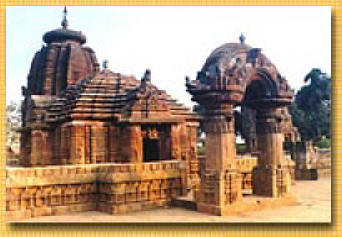-:
Hindu Temples :-
Lord Shiva Temples
Mukteswara Temple

This temple is often referred to as the "gem of Orissan Architecture" and has been built on the lines of the Kalinga School of temple architecture. It is dedicated to Lord Shiva - Mukteswara and is carved with figures of ascetics in various poses of meditation. A dip in a sacred well to the east of the temple is said to be a cure for infertility.
The frequency with which the term 'gem' is employed is immediately appreciated with the very first glimpse of this delicate, refined little structure. In addition to its beauty, this temple is important as a transition point between the early and later phases of the Kalinga School of temple architecture, where the builder has successfully combined many elements of the old with new designs and conceptions. Many of the innovations took root, and became essential features of all later temples and this made one, describe the Mukteswara as "harbinger of the new culture". The relationship with older structures can be immediately seen in the small size of the temple - 35 feet (11 meters) high at the pinnacle of the tower. At this stage, Orissan builders had not yet attempted the later colossal structures. The latticed windows of the 'Jagmohana' (porch) were probably modelled on those of the Parsurameswara temple, and the octagonal compound wall seems to have been patterned on an earlier structure, which now exists only in fragmentary form. A 'torana' (arched gateway), which was excavated in a field near Bhubaneswar in fragments, is now in the Orissa State Museum. Its extraordinarily beautiful sculpture includes elaborate scrolls, graceful female figures, monkeys, peacocks, and a wealth of delicate and lovely decorative detail.
The
innovations are even more interesting to note. The Jagmohana building has
become a structure in its own right, and has begun to show the later shape
of a terraced pyramid (although the internal shape has not yet become a real
square). Both buildings are now on platforms, and their component parts have
become more fully accentuated. Over the doorway to the inner sanctum, the
ninth planet (Ketu, identified by the canopied, three hooded snake) has been
introduced. On the other hand, haloes have been removed from the cult
images. In general, comparing this temple to the earlier Parsurameswara, one
gets to notice an overall lightening of effect. Almost all of the sculptures
on the temple are wonderful. Around the windows of the Jagmohana are monkeys
engaged in a variety of humorous and lively scenes depicting popular stories
from Panchatantra (Indian ancient tales). The image of a mythical lion head
with open jaws, flanked by attendants, over an elaborate horseshoe shaped 'chaitya'
arch (found on the southern exterior projecting wall of the tower) is common
on Tantric shrines, and is found on many later Orissan temples. This is the
first and the finest appearance of the image. There are a number of
depictions of skeletal ascetics among the sculptural images, most of them
shown in teaching or meditation poses. Some scholars have suggested that
this relates to the role of the temple as a center for Tantric initiation.
The name Mukteswara ('the Lord who bestows freedom through Yoga') might
support this view. On the outer face of the compound wall are niches
containing a variety of divinities. These include Saraswati (sitting on a
lotus with two female attendants), Ganesa (with his attendant mouse), and
Lakulisha (the fifth century founder of the Pashupata sect of tantric
Shaivism), who is portrayed sitting cross-legged, with two miniature ascetic
figures in the triangular side panels. Several small shrines can be noticed
within the compound, many with lingam inside. These were offering shrines
depicting utmost faith in God for all purposes during that era.